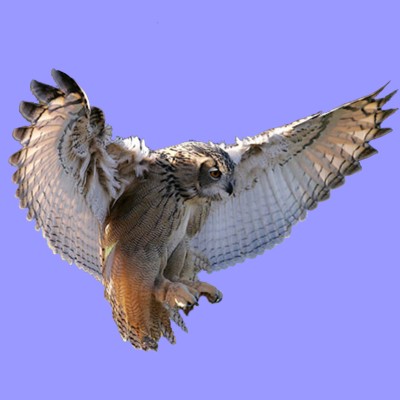Eurasian Eagle Owl, Bubo bubo
The Eurasian Eagle Owl is the biggest of all nocturnal birds of prey resident on the Iberian Peninsula, reaching 60-70cm in length and approx. 1,5-2,5kg in weight. Average wingspan is 180cm. The species presents clear sexual dimorphism, with the females being larger than the males. The size, ear tufts and orange eyes make the Eurasian Eagle Owl a distinctive species. Plumage in brown tones.
The legs and feet are covered in feathers up to the talons, both the beak and claws are black. The plumage of the chicks is white in the beginning, turning into brownish-grey when getting older.
 Main characteristics
Main characteristics
Eurasian Eagle Owls occupy a variety of habitats, from coniferous forests to warm deserts. Rocky landscapes are often favoured. Adequate food supply and nesting sites seem to be the most important prerequisites. They often nest close to the ground, at the foot of trees. The Bubo bubo hispanus is native to the Iberian Peninsula. Being a little bit smaller than Bubo bubo, which is distributed all over Europe, Bubo bubo hispanus inhabits practically all regions of Spain, except for the islands. Its population density is lower in the northern part of the country.
The Eurasian Eagle Owl is strictly territorial. The size of its territory depends on the availability of prey, but it will always expand over various kilometres. Eagle Owls mark their territory by vocalizing their typical sounds from delimitating trees. Eagle Owls are monogamous, pairs may remain together throughout the year. Owls are powerful raptors, hunting on a great variety of prey, depending on the local abundance and availability.
On the Iberian Peninsula, the Eagle Owl density is directly related to the abundance of rabbits as preferred prey. Where the rabbit population is low, it is substituted by other small mammals, such as voles or rats. They also hunt on medium-large birds (including other birds of prey), snakes, lizards, frogs, fish, crabs or bugs.
Courtship and marking of the territory starts usually in November-December, and it will continue until the beginning of the year. Eurasian Eagle Owls do not build their own nests. A clutch of normally 3 eggs are laid between February and April. They are normally laid at 2 to 4 days intervals. Once hatched, the chicks abandon the nest after 28-35 days, still unable to fly. Fledged young are cared for by both parents for still some more time. After 60 days they are able to fly.
Its size makes the Eurasian Eagle Owl a distinctive species. Two subspecies are native to the European continent:
B.b.bubo: all over Europe, down to the Pyrenees.
B.b.hispanicus: on the Iberian Peninsula.
Eurasian Eagle Owl, Bubo bubo
Facts:
How are they? One of the biggest nocturnal raptors, with a length of 70cm from beak to tail and a wingspan of 2m. Its Latin name Bubo bubo may derive from its typical call. The whole of the underparts except for chin, throat and centre of upper breast is covered with fine dark wavy barring, on a tawny-buff ground colour. Their colouring allows them to camouflage with their surrounding. Eurasian Eagle Owls have ear tufts on each side of the head and a V-shaped line between their orange eyes.
Where do they live? In forests and rocky areas, normally far away from human settlements.
How is the species geographically distributed? Europe, Asia and Africa.
What do they feed on? It hunts small rodents, rabbits, hares, squirrels, rats, pigeons, blackbirds and hedgehogs. Occasionally, it may hunt on foxes and fawns up to 10kg. Exceptionally, it may even feed on frogs, big insects and fish.


